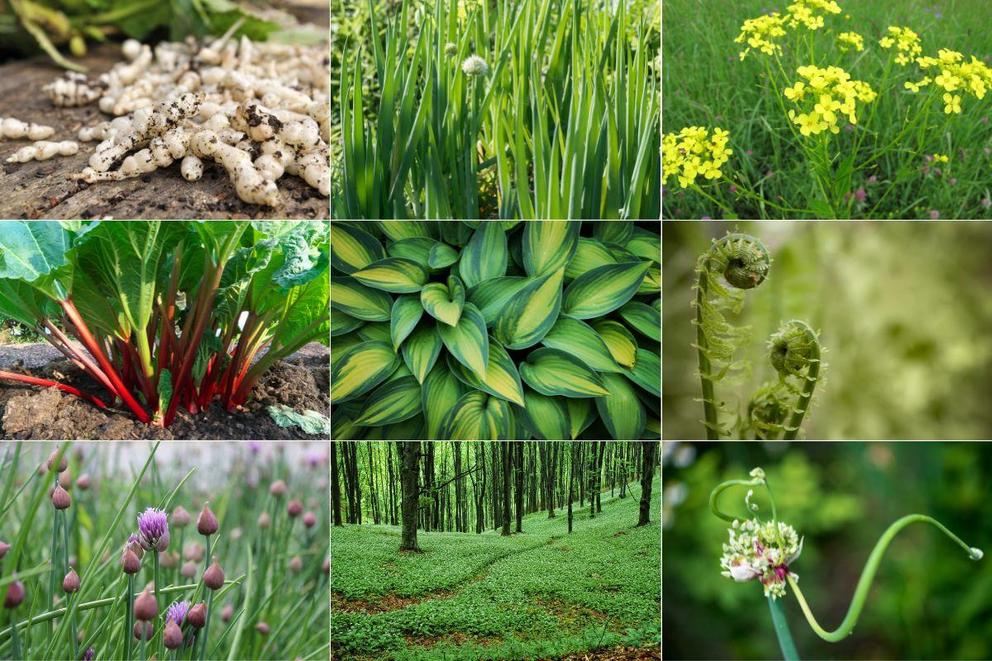
20 plus perennial vegetables that grow in shade
Growing food in shady spaces is easier than you might think, and with these perennial crops, you can plant once and harvest for a lifetime.
Shade gardening can be tricky, and the vast majority of garden plants require at least part sun (if not full sun) to thrive. They need all that extra energy to produce fruit, and tomatoes just won’t go anywhere without enough sun.
Some annual vegetables can be grown in shade, mostly things like lettuce and cabbage can tolerate shade because they don’t set fruit. They’re particularly tasty to deer and vulnerable to weeds, so they’re not the best choice for planting in shady spots on the front lawn.
More importantly, they must be tended and replanted every single year. They are “annuals,” after all.
What if I told you there were plenty of crops you could plant once, and harvest for a lifetime, all from full shade?
I’ve already gone through more than 30 Perennial Vegetables that we grow on our homestead, but many of those are grown in full sun, just like annual vegetables. Some, however, can do just fine in part shade or even full shade. And many of them simply can not grow WITHOUT full shade, believe it or not.
Wouldn’t you like to put that shady corner of the yard to good use, without a lot of extra work?
All of these perennial plants grow in shade. I’ll take you through all of the shade-tolerant perennial vegetables one by one, and then I also have a few bonus shade-tolerant perennial fruits for you too.
Understanding The Types of Shade
When you select plants for your garden, look at the description, which should tell you how much sunlight or shade a plant tolerates. Plants belong to one of three categories to help you understand where your plants will thrive the best on your property.
- Full Sunlight: When you see that a plant requires full sunlight, that means they need 6+ hours of direct sunlight per day. It’s common to see this requirement for annual vegetables like tomato plants.
- Part Shade or Part Sun: The tag on the plant may say it requires part shade or part sun, but both terms mean the same thing. These plants require three to six hours of sunlight each day.
- Full Shade: Generally, most plants require some sort of sunlight, but the full shade plants only need three hours per day.
Understanding the distinction is essential when deciding what plants to put where since sunlight varies greatly, even in your backyard. For example, a large tree may cast a shadow over an area, limiting that area to part shade, but the other part of your yard only receives morning sunlight.
That’s why I recommend observing your yard for several months before choosing where to place perennials. Perennials are only planted one time, so you need to get the location right the first time.
Consider any trees or bushes that may not be in full bloom when checking for sunlight amounts. That changes how much your plants get in the summer when you typically expect them to produce for you.
Perennials Vegetables That Grow in Shade
It’s not too hard to fruit perennial fruits that grow in the shade, but what about greens and vegetables? Unfortunately, finding edible perennial greens tolerating at least partial shade is harder. Luckily, your shady location is not out of luck; keep reading to see some greens to add to your garden.
Caucasian Mountain Spinach
When looking for edible perennial greens, make sure you include Caucasian Mountain Spinach. This is a cold hardy green, similar to New Zealand Spinach, which only grows in warm climates.
It’s challenging to find hardy perennial vegetables that are greens, but Caucasian Mountain Spinach is an excellent option. It grows up to nine inches tall in the early spring with tasty, edible shoots and leaves. In addition, they taste like spinach without any of the bitterness many people find unappetizing.
This plant grows well in the shade but is best in full sunlight. Therefore, more sunlight maximizes the production and growth of this plant.
Hardy to zone 3.
Chinese Artichoke
Here is another perennial green that grows well in the shade. Chinese artichoke is closely related to the mint family, spreading out in a dense, low-growing plant. Under the soil, Chinese artichoke grows small tubers, roughly one to two inches long.
When eating Chinese artichoke, you’ll notice the tubers have a mild, sweet flavor with the perfect crunchy texture. We enjoy eating the tubers sauteed in butter with plenty of herbs – delicious!
When planting Chinese artichoke, pay attention to your USDA zone; it’s hardy up to zone 5. However, some gardeners say it grows into zone 4, but it may require some trial and error in your garden to decide if that works for your area.

Chives
Chives are a determined perennial herb that seems to thrive no matter what you toss its way. Growing chives in the shade may not be as productive, but you’ll see plenty of chives throughout the growing season.
Growing chives is relatively easy; it’s perfect for beginners new to perennial plants. Once planted, they grow steadily for years, popping up early in the season compared to other plants.
Hardy to zone 3.
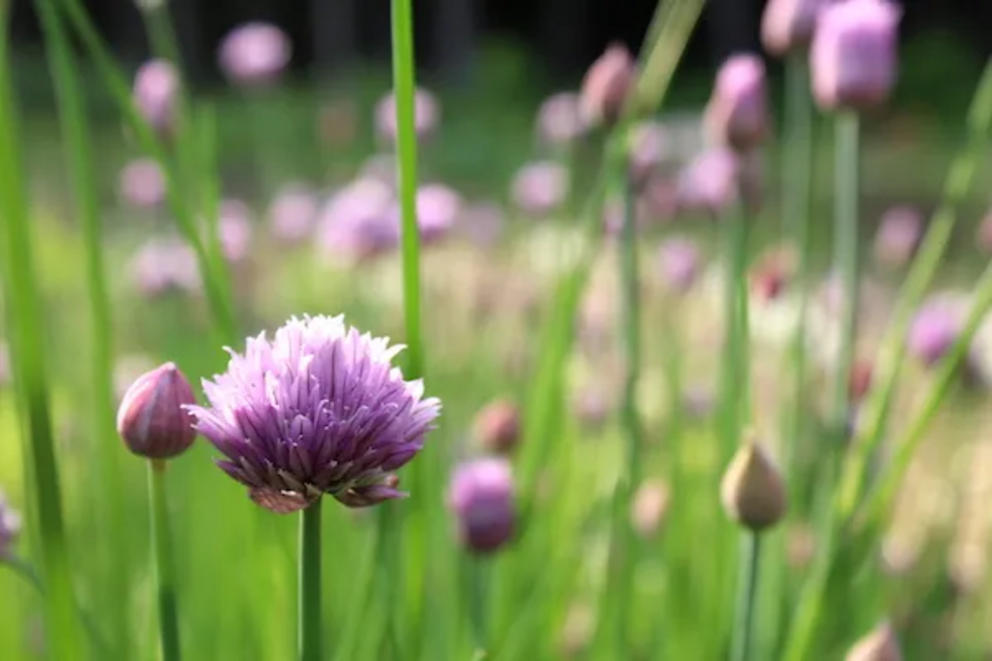
Daylilies
Those orange-colored flowers that grow along everyone’s shed are edible perennials. People tend to plant them anywhere because daylilies thrive in most conditions.
Believe it or not, daylilies came to the Americas from Europe because it was a cultivated food source. It’s still common in Asian countries as a food crop. Dried daylilies thicken and flavor soups and stews.
If you want to plant daylilies as an edible perennial, be sure to check the variety you plant. We know with certainty that Hemerocallis fulva is edible; all parts of the flowers are edible. The tubers are also edible and have a flavor similar to nutty potatoes. You also can consume the shoots and leaves, which taste like a blend of cucumbers and lettuce.
Hardy to zone 4, but some varieties will grow down to zone 2.
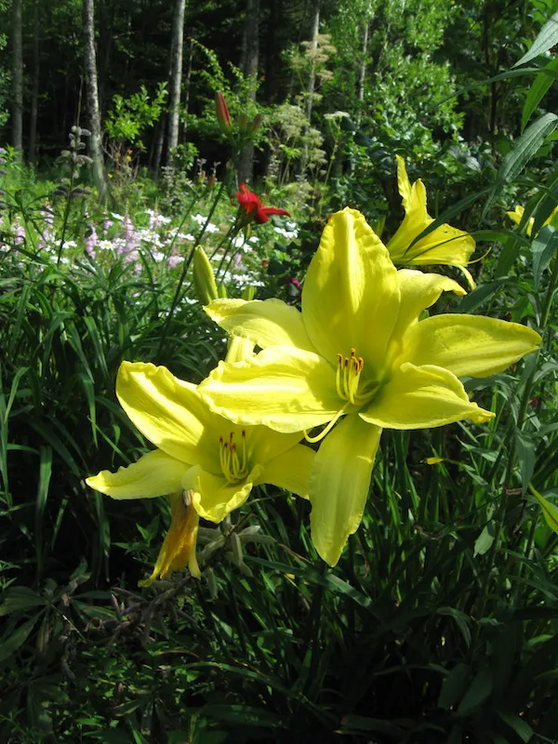
Fiddlehead Ferns
Ferns pop up in the early spring, covering the earth with warmth and color. Most people assume ferns are a dependable perennial plant, but many never realize that ostrich ferns produce edible fiddleheads.
Fiddleheads are unfurled fronds that taste similar to asparagus. Ostrich ferns prefer growing in shady spots, and after the fiddleheads develop, the plants continue to act as ornamental plants for the rest of the year.
Many people only grow Ostrich ferns for their beauty, but spring fiddleheads are coveted in fine-dining restaurants. Those fiddleheads are wild foraged, but there’s no reason you can’t grow them at home.
Hardy to zone 3.
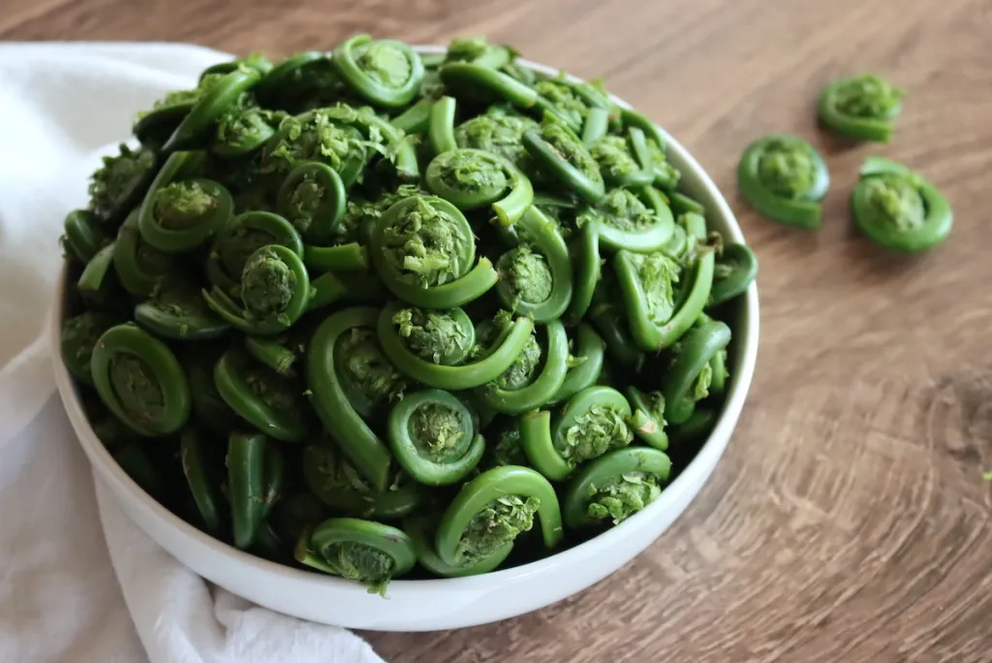
Fiddle-head ferns in a bowl, cleaned and ready for cooking.
Good King Henry
If you want more edible perennials that grow in the shade, consider Good King Henry. This is a perennial plant that produces greens year after year. The sprouts taste similar to asparagus, and the leaves resemble spinach.
You get a bonus with Good King Henry. The seeds cook up and taste similar to quinoa. So, not only do you get greens, but you get a part of the plant that acts similar to grains as well.
You’ll find many ways to enjoy this edible perennial. The pencil-thick shoots are great for steaming or baking, similar to how you would cook asparagus. Try cooking the greens by boiling or steaming them; eating the leaves raw isn’t the best idea. They are rather bitter, but blanching or boiling decreases the overall bitterness.
Hardy to zone 3.

Hostas
Most people don’t realize that hostas are edible and have trouble growing in full sun. They need the protection of shade to thrive.
Originally a wild edible woodland plant from Japan, they still forage there in the wild. Unfortunately, they were exported to other countries as ornamentals somewhere along the line, and everyone quickly forgot that they’re a tasty edible.
These days, most people just appreciate their lush green foliage, bright flower spikes, and carefree maintenance. However, hostas are edible, and their shoots taste like asparagus. Each hosta variety has a different flavor, and this plant’s parts are edible.
You can learn how to cook hostas at home, so you’ll always have them each spring.
Hardy to zone 3.

variegated hosta (striped) and green hosta side by side
Lovage
I don’t grow lovage on our permaculture homestead because it’s perennial celery that reaches up to six feet tall. I’m not a huge fan of celery, but if you love celery, lovage could be a great perennial for growing. It’s often called mountain celery due to its size and taste.
Lovage is part of the Apiaceae family; it’s a perennial herb related to cilantro, dill, fennel, carrots, and celery. All parts of lovage are edible, including the seeds and roots. The plant produces best when it grows in more sunlight but tolerates partial shade.
Overall, this plant is quite low maintenance. Therefore, you won’t have to put too much into maintaining these plants.
It’s easy to find ways to use lovage. For example, it added celery flavor to soups, stews, and salads. You can use the leaves for tea as well.
Hardy to zone 3.

Nine Star Broccoli
Despite the name Nine Star Broccoli, this plant is a perennial cauliflower producing ten or more tennis-balled-sized yellow heads each year. This is awesome, considering annual cauliflower only produces one head with the potential of a few more shoots.
The name “Nine Star” comes from its growth habit. Throughout the year, you’ll find various harvests. In early spring, a small head appears; be sure to harvest and eat it. Then, nine or so smaller florets appear around the central head throughout the year. This is similar to sprouted broccoli.
If you properly feed your plants, it’s possible for even more heads to appear than nine! This plant is endangered, and it’s an excellent pollinator plant as well. Be sure to cut the plants back in summer and mulch well for over the winter.
This one’s only hardy to zone 7, but it’s perfect for warmer climates.
Rhubarb
Many assume that rhubarb only grows in full sunlight, but that assumption would be wrong. Rhubarb is by far one of the easiest perennial plants in my garden, and it thrives in sun and partial shade. You typically need to have some sunlight for rhubarb to grow, but partial shade works great.
Rhubarb also grows in various soil types, but keep it away from boggy soil. However, it grows nearly anywhere, and adding plenty of organic matter to your soil will increase its growth potential.
It takes several years for rhubarb to reach a harvestable size, but once it does, the plant will continue to produce for you. Best of all, this plant is easy to divide in early spring, so share it with your family or plant other places in your garden.
Most people opt for rhubarb crowns from a nursary supply store, but you can also grow rhubarb from seed.
However, be sure to only eat the stems when harvesting rhubarb; the leaves are not edible. In general, rhubarb, while it is a vegetable, is treated like a fruit, and most bake it into pies, muffins, crumbles, and jam. We love strawberry rhubarb jam!
Hardy to zone 3.
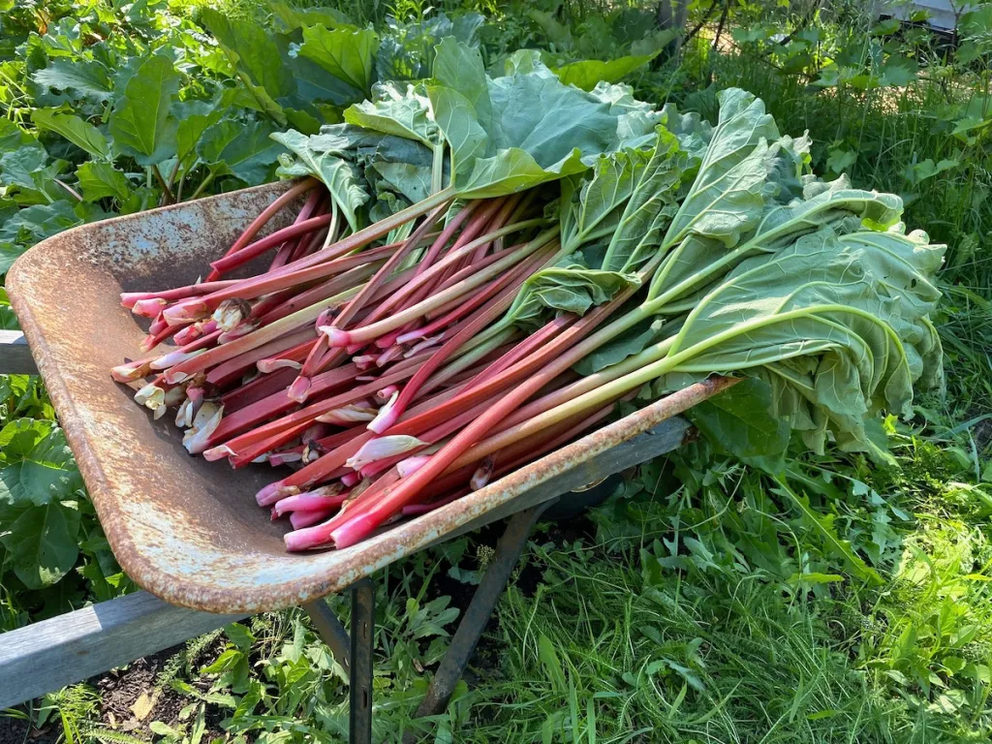
Part of our rhubarb harvest in a wheelbarrow
Ramps
Ramp season is a big deal for serious foodies; you won’t find these in your local grocery store. Often called wild garlic, ramps grow in deciduous forests, where the soil is rich with organic matter.
Ramps are spring ephemerals and pop up before the trees are full of leaves. It takes several years for ramps to produce and have a sizable harvest. However, once they start growing, these plants will produce tasty greens for you for years to come.
The taste is similar to a cross between garlic and onions; this is a wild leek plant. You can eat the greens and the bulbs, but if you eat the bulbs, they won’t grow back the next year.
This guide will teach you how to grow ramps (wild leeks), and you can buy ramp seeds here.
Hardy to zone 3.

Rampsons (Bear Garlic)
Similar to ramps in some ways, Bear Garlic or Rampsons are a variety of wild allium that carpets woodlands in the UK.
They can be cultivated as well.
Hardy to zone 5.
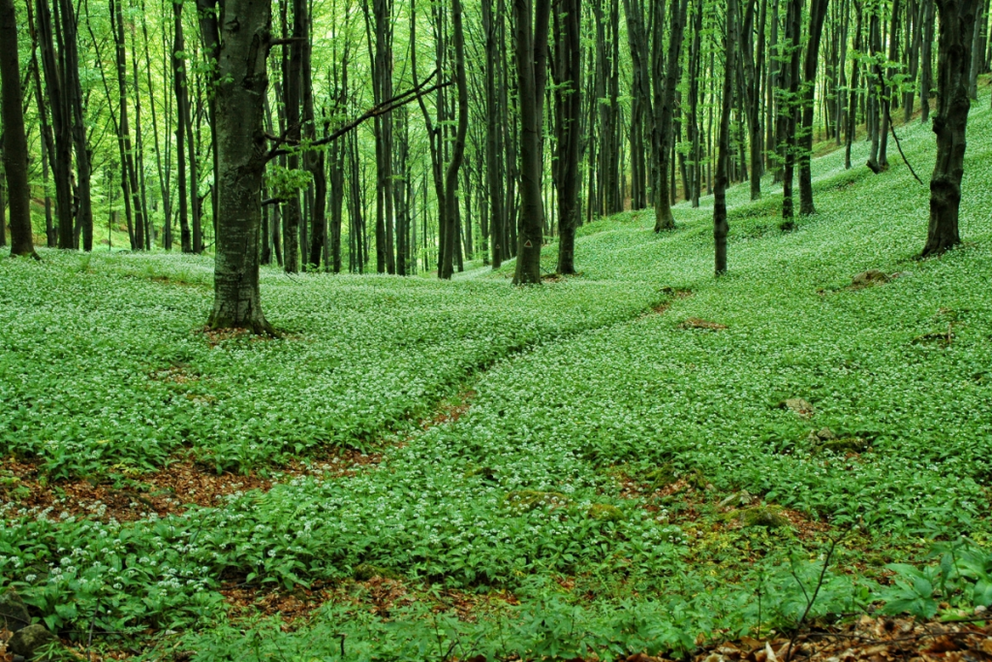
Scallions
Most people don’t realize scallions are perennials; most grow these plants as annuals instead. In the first year, scallions are small, so they’re great for adding to stir-fries or other recipes.
However, over time, scallions get quite large, and if you leave them in the garden, they turn into perennials. You won’t believe how tall the scallions can get! The stalks reach up to four or five feet tall.
Hardy to zone 4.

Skirret
Here is another perennial vegetable you may have never heard of before. Skirret originated in China and spread west throughout the Middle Ages. It is a perennial version of parsnips with a lowered yield, but the taste is similar. Skirret produces thinner roots and produces slower than traditional parsnips.
Since the production is slow, skirret never became a commercial crop. However, that doesn’t mean you cannot enjoy the vegetable in your family vegetable garden.
You can essentially plant skirret and forget about it until you are ready to use it in two years.
Hardy to zone 5.
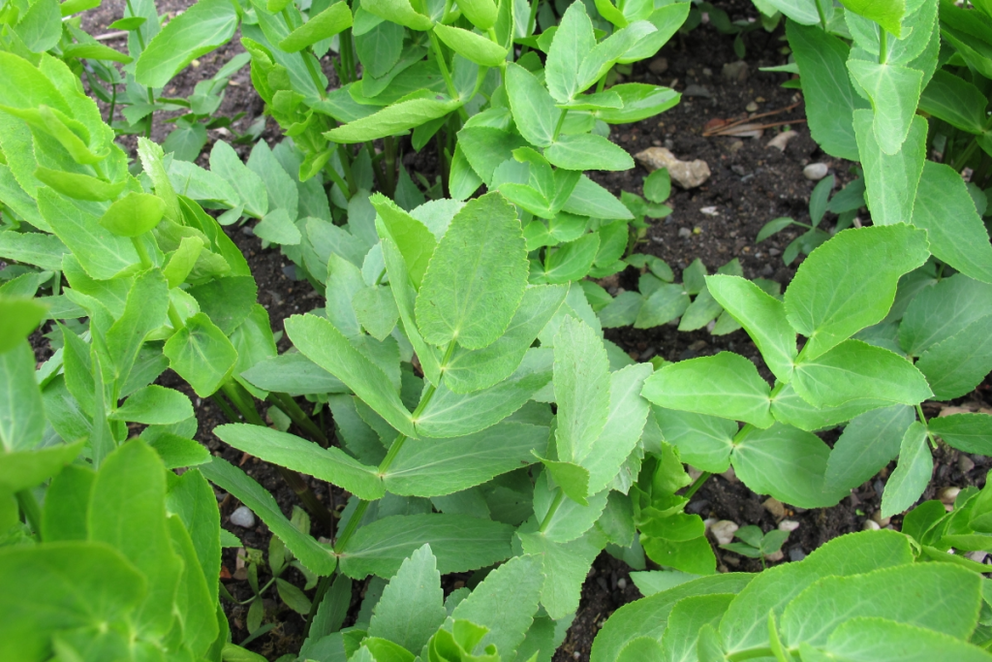
Stinging Nettle
Stinging Nettle is one of those plants that may be your enemy if you aren’t aware of their powers. I never knew what happened when you grabbed the plants until I found them while weeding my garden.
Ouch.
You end up suffering from burning paint throughout the day. It’s not fun at all. The little thorns cause a stinging sensation when you touch the plant.
Don’t let their scary exterior stop you from enjoying this delicious plant. If you harvest stinging nettles with gloves, they taste great. We enjoy stinging nettle soup, which also has medicinal properties. Cooking the plant kills its sting, and they taste similar to spinach.
Hardy to zone 4.
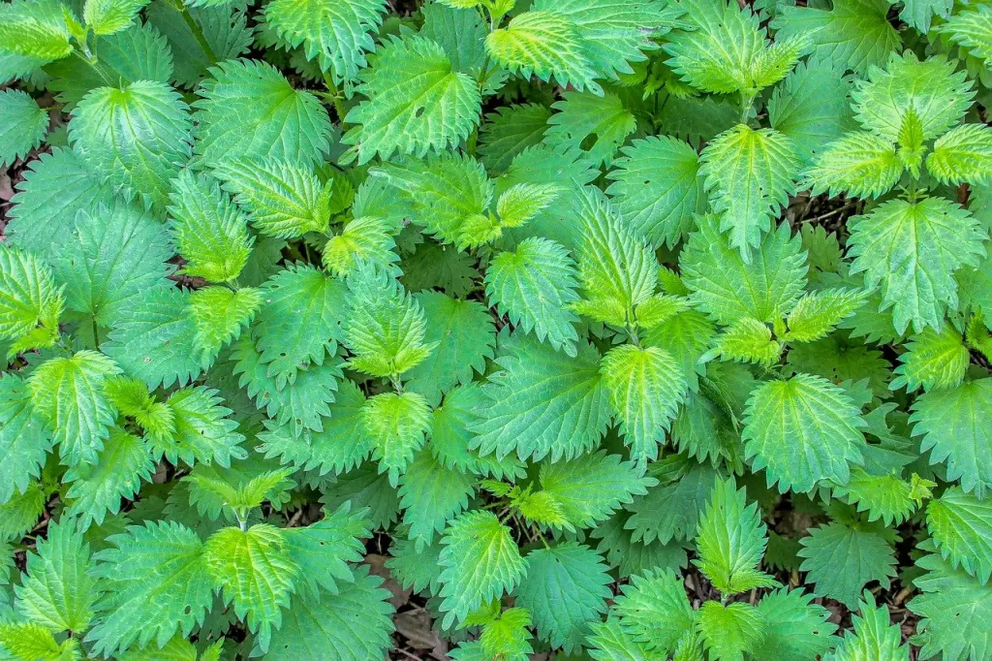
Stinging Nettles
Sweet Cecily
Sweet Cecily is a self-seeding member of the carrot family. This plant grows and spreads rapidly wherever you plant it, so take some time to consider the best placement before picking its final home.
Permaculture gardeners plant it beneath trees to attract beneficial insects, and it doesn’t mind the shade. Pollinators especially love the spring flowers.
Hardy to zone 3.
Three Cornered Leek
The three-cornered leek is called wild garlic or onion weed in different areas of the world. While it goes by many names depending on where it grows, this plant is a garlicky, wild onion plant that originates in the Mediterranean region of the world.
All parts of this plant are edible, including the roots, flowers, leaves, and flower stems. When cutting a leaf, the plant has three corners with a subtle triangle shape.
You’ll find these plants growing in dappled shade. It’s easy to identify the plants because the flowers are white and bell-shaped; they look like snowdrops. The petals have a green vein, and when you take a sniff, you’ll get hints of onions and garlic.
Hardy to zone 7, so best for warmer climates.
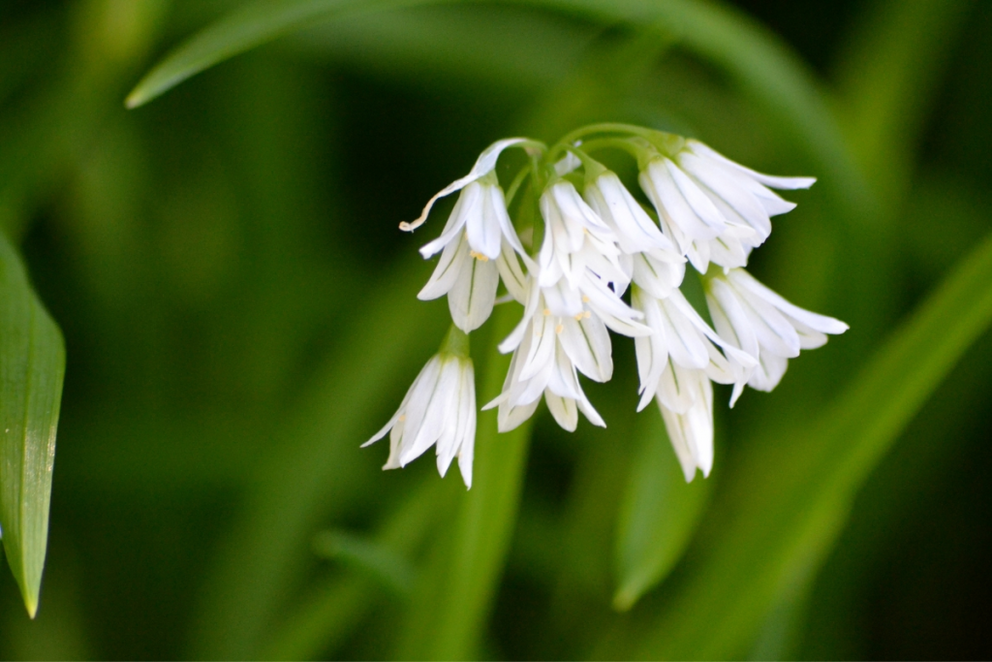
Three Cornered Leek
Turkish Rocket
I recently tried growing Turkish Rocket, and none of the plants grew well. I’m going to try again this year; we hope to have these greens in our garden.
Turkish Rocket produces tender, spicy mustard greens, and florets, perfect for stir-fry dishes. The larger leaves are harvestable throughout most of the growing season.
If you live somewhere with droughts, you definitely want to grow Turkish Rocket. It is a drought-tolerant plant due to its large, deep taproots that search our water. Some consider this plant invasive, but that depends on the locale. In some areas, this plant spreads faster than others.
Hardy to zone 4.

Walking Onions
Egyptian Walking Onions are a unique perennial vegetable that grows quickly, spreading throughout your garden. However, it is easy to control, and you can always pull up the onions to eat and enjoy before they invade parts of your neighboring gardens.
In early spring, you’ll find green shoots emerging, and use these like scallions. By the early summer, tiny bulbs top the stems, and the bulb gets heavier and larger over time. Eventually, the bulbs cause the plants to topple over.
Then, the bulb roots once it touches the ground, and a new plant emerges. This is how it essentially “walks” over your garden. If you don’t want the onions to spread, you need to harvest them.
Walking onions harvest well and store in a cool area of your house. If you want to store them, make sure to dry and cure them for a week or two before storage to maintain the delicious oniony flavor.
This guide will teach you how to grow walking onions.
Hardy to zone 3.
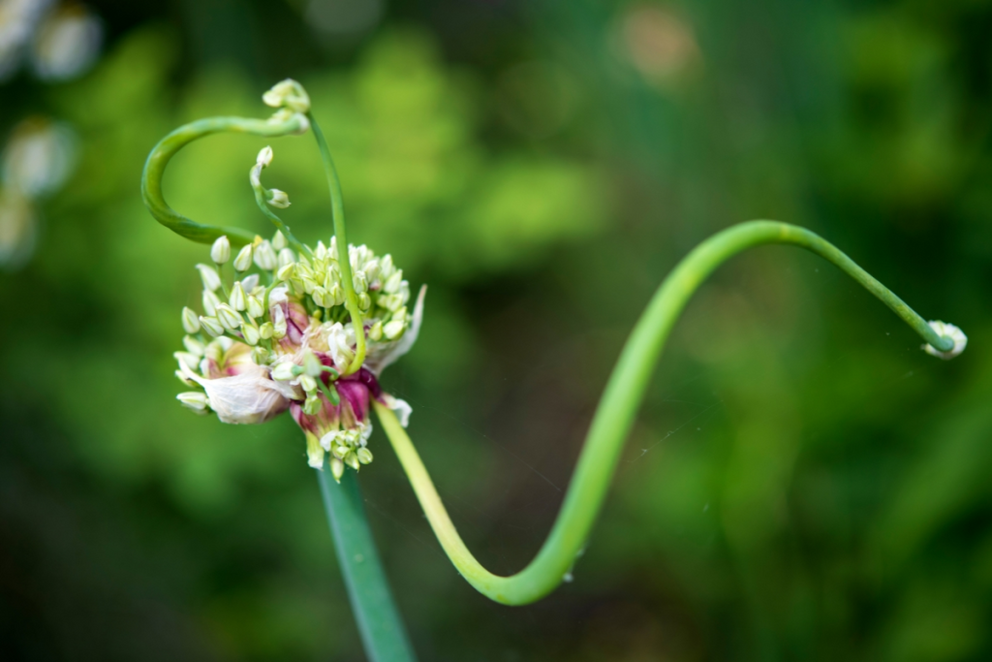
Watercress
Watercress are delicious salad greens that are also perennial vegetables. Unfortunately, these plants grow best when located near water, making them a bit tricky to add to your garden.
Believe it or not, some believe watercress is one of the oldest greens humans consumed. It dates back to the ancient Greeks and Romans; it was a wild food throughout Europe and Asia.
Nowadays, watercress is best known as a fancy green you find at expensive grocery stores. The cost is due to its finicky nature; it wants a wet location. That makes sense, given its name. You may not have a pond, but if you have a stream, consider adding a patch of watercress nearby.
Another idea is to plant watercress in the areas of your property that seem to hold water after a storm longer. You know, the areas that seem to keep puddles forever – plant there.
Hardy to zone 3.
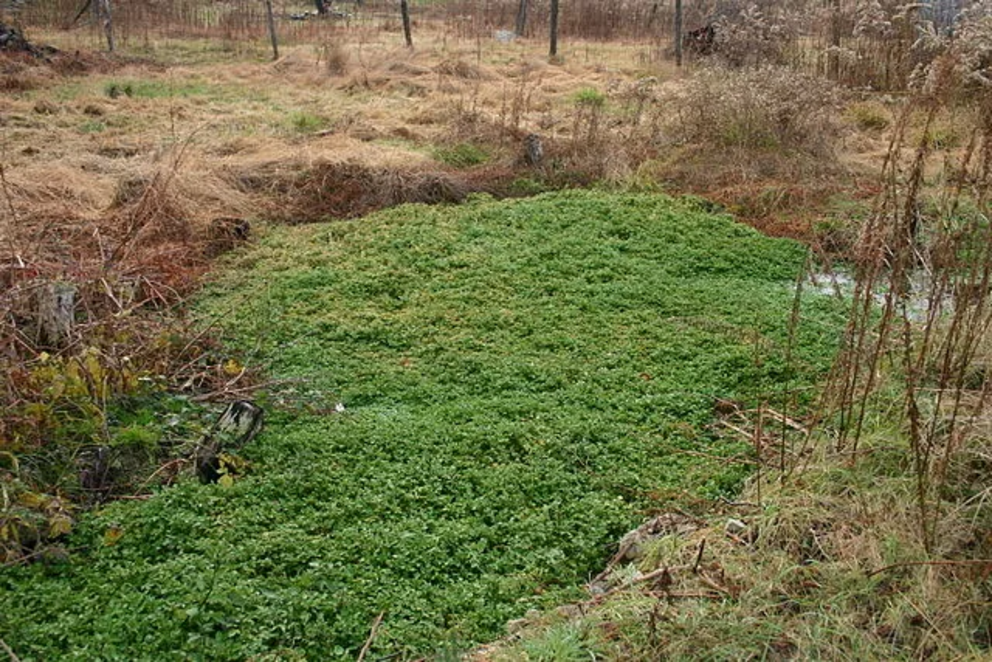
Watercress growing in a low wet spot
Perennial Fruits that Grow in the Shade
Most people are a lot more familiar with perennial fruits than they are vegetables. Everyone’s heard of apple trees and blueberry bushes.
The thing is, almost all fruiting plants need full sun to thrive. There are plenty of notable exceptions, and given that we have a shady woodland homestead, I’ve really gone out of my way to seek out shade tolerant fruiting plants.
Some require part sun to grow, but there are a few that thrive and produce heavy crops in full shade. Black currants, for example, love full shade, and will actually die if planted in full sun.
I have a list of more than 20 fruits that grow in the shade, but here are a few of them to get you started.
Alpine Strawberries
You might be surprised to find that one type of strawberries grows in the shade – alpine strawberries. These work as a ground covering under trees, covering the shady areas with wild, delicious strawberries.
Alpine Strawberries are small when compared to the strawberries you find in the store. However, they are delicious and have a pineapple flavor unique to this strawberry variety.
Most varieties are hardy to zone 5, but there are plenty that will thrive as cold as zone 3.
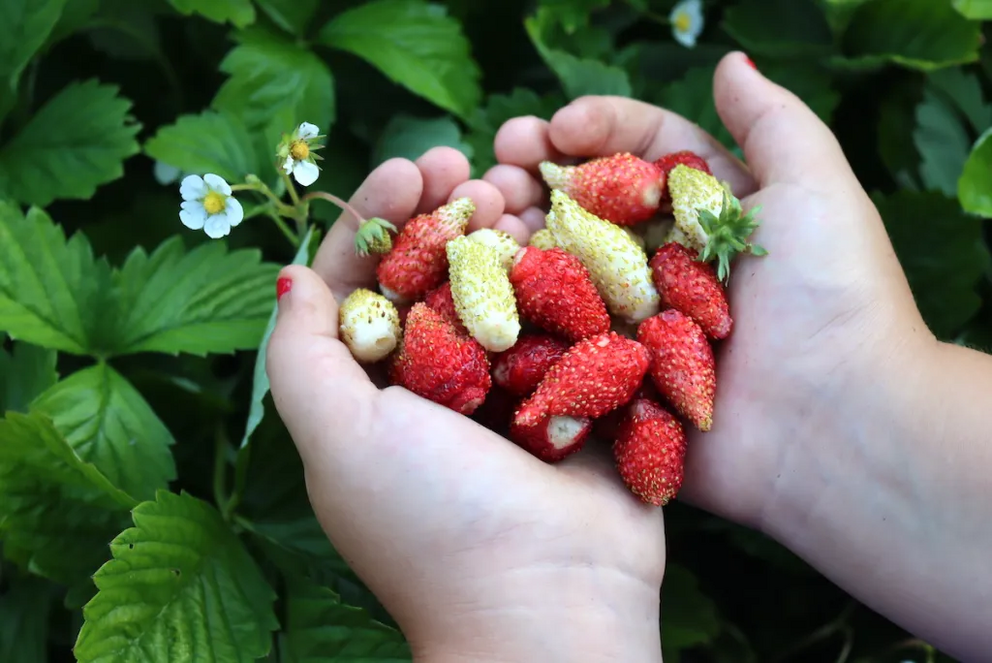
Alpine Strawberries
Arctic Beauty Kiwi
Growing fruits in cold regions is tricky; most fruit-bearing plants require more sun hours and higher temperatures. Arctic Beauty Kiwi is an exception, originating in eastern Russia’s forests.
Arctic Beauty Hardy Kiwi is the hardiest out of all the kiwi species. The plant produces a large, gorgeous vine with airy foliage splashed with green, white, and pink variegation.
This variety is happy with some shady, so it’s great if you have a north side of the fence, arbor, or trellis. Not only does it offer ornamental value for your backyard since the vines are gorgeous, but it also produces fruits to enjoy.
Hardy all the way done to zone 2!
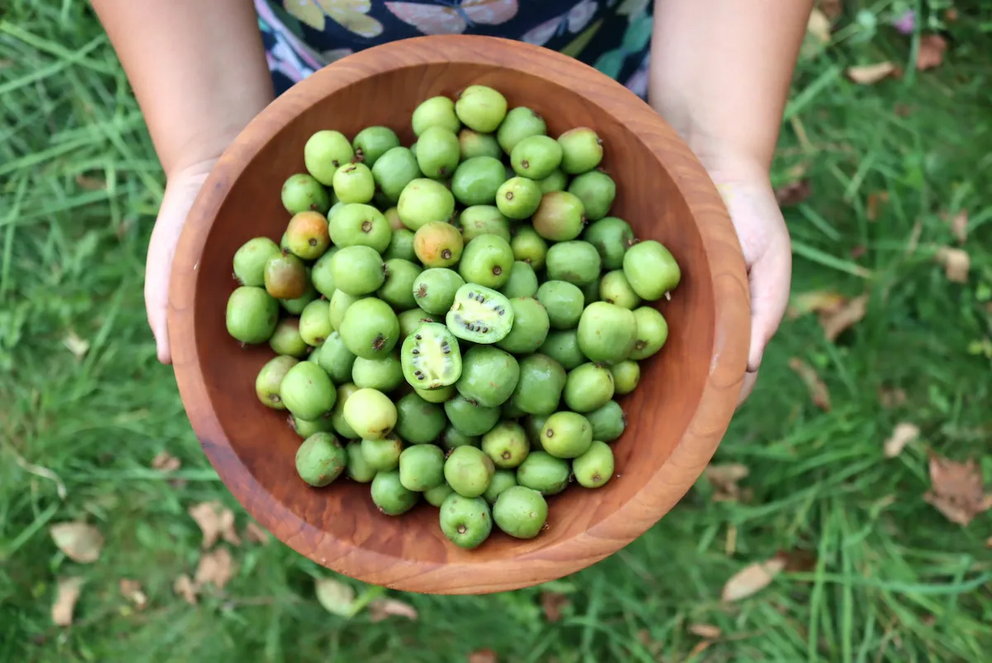
Hardy Kiwi Fruit
Black Raspberries
Yes, that says black raspberries, not blackberries. Black raspberries are known for being relatively shade tolerant and have a unique flavor you are sure to appreciate. Planting black raspberries in full sunlight may lead to a larger harvest, but the plants still produce plenty of fruits in partial shade.
Black raspberries grow from canes, and the second-year canes start to produce fruits. Like other perennial fruits, it takes several years for these fruits to produce their full potential.
Hardy to zone 3.
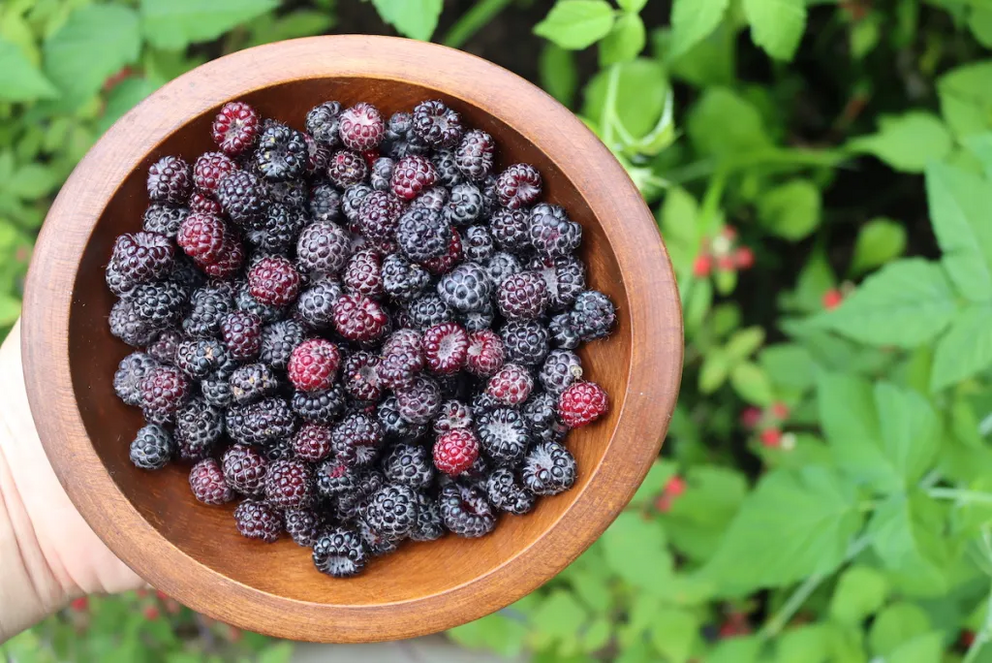
Currants
Currants aren’t a popular fruit in the Americas, but if you head over to Europe, you’ll find all sorts of dishes utilizing these little berries. People all around the world love currants, and you have the opportunity to grow them, even if you have more shade than sunlight in your backyard.
Currants are an easy-to-grow, perennial fruit that looks great in your landscape. The shrubs burst with pretty clusters of flowers that turn into groups of pink, red, white, or black currants.
Adding currants to your backyard is a great idea. Not only are they tasty and usable in many recipes, but they are high in antioxidants with a vitamin C level higher than oranges!
Hardy to zone 3.

Huckleberries
Huckleberries are a perennial shrub that grows up to three feet tall in sunlight, but the shrub reaches up to six or more feet tall when grown in the shade.
These shrubs produce pea-sized fruits that taste similar to blueberries. You can find different species native to North America; your local nursery may suggest huckleberry varieties that grow in your region.
Huckleberries have a tangy, unique taste that makes them perfect for jams and desserts. Your family will love some huckleberry pie, and the plant also has ornamental value for your garden. The leaves turn bronzed red in the summer.
The downside to huckleberries is that these shrubs take quite a while to reach full maturity. Expect to wait over ten years before you see a complete harvest!
Hardy to zone 3.
Pawpaws
Are you looking for a unique fruit tree that grows in a shady area? Check out Pawpaws!
Pawpaws are perennial plants that create delicious fruits. The fruits have a flavor between a banana and mango, making them quite fruit for a perennial garden.
These trees have long taproots, so they need ample space for growth. You also must have more than one pawpaw tree because it cannot self-pollinate. Plant the trees 12-15 feet apart, giving them ample growing.
Most varieties are hardy to zone 5, but some people are now growing specific varieties in zone 4.
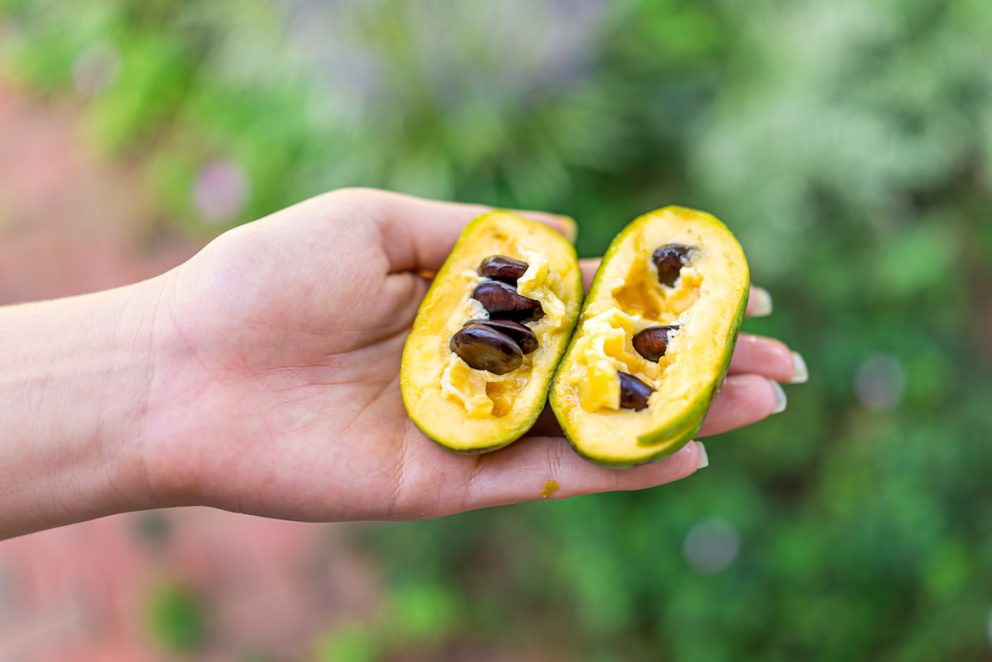
Pawpaw Fruit
Schisandra
It’s hard to describe Schisandra if you have never tried it before. It seems more like a fruit than a vegetable, and we recently added it to our permaculture garden. Schisandra has a long history in Chinese medicine with several herbal properties.
This plant produces a long, woody vine with pink-white flowers. Then, in the late summer, the flowers turn into red berries that are an interesting flavor. It’s said that these berries have a sweet, sour, bitter, spicy, and salty flavor – basically, a flavor explosion in your mouth!
You’ll need somewhere for these vines to grow, such as a trellis. However, they will climb almost anything. Make sure you have well-draining soil and full to dappled shade for overall ideal growth.
Hardy to zone 4.
Wintergreen Berries
Do you have a spot in your garden that needs a ground cover, but you also want to produce food? Consider growing wintergreen berries.
Wintergreen berries are low-growing berry plant that creates gorgeous ground cover. In addition, the plant produces edible berries and leaves that taste delicious for tea.
These plants tolerate some sunlight, but, in general, they prefer to grow in the shade.
Hardy to zone 3.
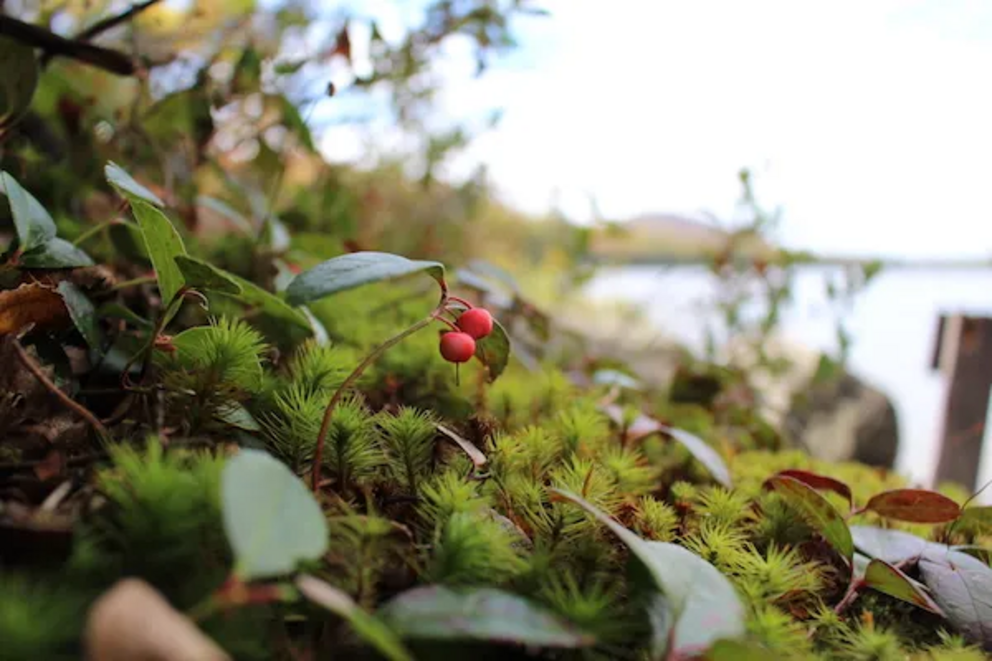
Teaberry, the fruits of the wintergeen plant, growing by a lake in Vermont.
Permaculture Guides
Looking for more ways to cultivate “permanent agriculture” right in your own backyard? Permaculture might be a good fit!
THANKS TO: https://nexusnewsfeed.com/article/food-cooking/20-plus-perennial-vegetables-that-grow-in-shade






 Sat Mar 23, 2024 11:33 pm by globalturbo
Sat Mar 23, 2024 11:33 pm by globalturbo

